Clipart tagged: ‘imperfections’

Ammonium Chloride
The form 3O3, {311} on Ammonium Chloride (Sal Ammoniac) may have only six of its twenty-four planes…
![This figure represents a crystal of iron pyrite showing representatives of all the forms of the isometric system except the rhombic dodecahedron: ∞O∞ {100} (P); O, {111} (d); [∞O2/2], π{102} (e); [4O2/2], π{214} (s); 2O2, {211} (o); and 3O, {133} (t). It is shortened in the direction of one of the principal axes, which, together with the fact that only two of the three faces belonging to the forms s, o, and t are developed in each octant, gives to it a decidedly orthorhombic habit.](https://etc.usf.edu/clipart/86800/86858/86858_crystal-of-iron-pyrite-showing-representatives_mth.gif)
Crystal of Iron Pyrite Showing Representatives of All the Forms of the Isometric System
This figure represents a crystal of iron pyrite showing representatives of all the forms of the isometric…
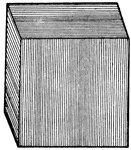
Cube of Iron Pyrite
Cubes of Iron Pyrites frequently show a striation of their planes in one direction, which is perpendicular…

Curvature of Crystal Planes (Diamond)
Curvature of crystal planes is quite a constant property of some substances. It may be due to a very…

Gold
Gold crystals of the form 3O3, {311}, sometimes resemble combinations of the rhombohedron and scalenohedron.
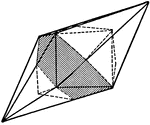
Green Fluorspar from Saxony
Certain crystals of green fluorspar from Saxony, showing the form ∞ 03, {310}, have one half of their…
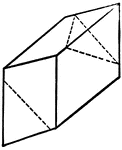
Magnetite
As shown on this crystal of Magnetite, the octohedron, by the crowding out of two of its opposite faces,…
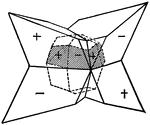
Potassium Chloride
The icositetrahedron, 4O4, {411}, on potassium chloride sometimes produces an apparent rhombohedron…
![It has been observed that the pentagonal dodecahedron, [∞o2/2], π {201}, on pyrite may have but six of its twelve planes developed in such a manner a to produce an apparent rhombohedron.](https://etc.usf.edu/clipart/86800/86856/86856_pyrite_mth.gif)
Pyrite
It has been observed that the pentagonal dodecahedron, [∞o2/2], π {201}, on pyrite may have but six…
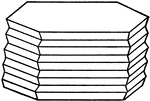
Striation of Crystal Planes
Striation of crystal planes may be produced by repeated polysynthetic twinning. This is well illustrated…